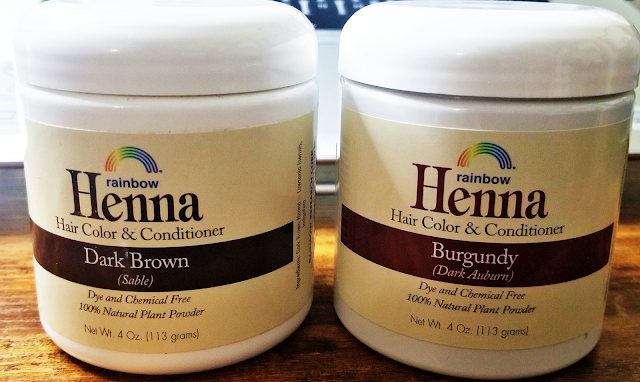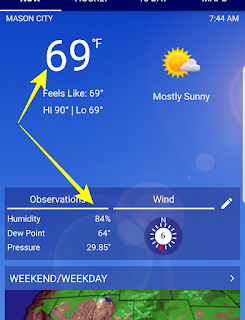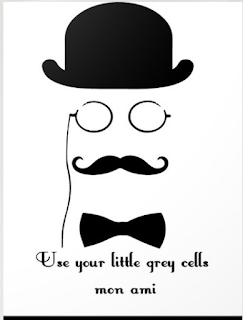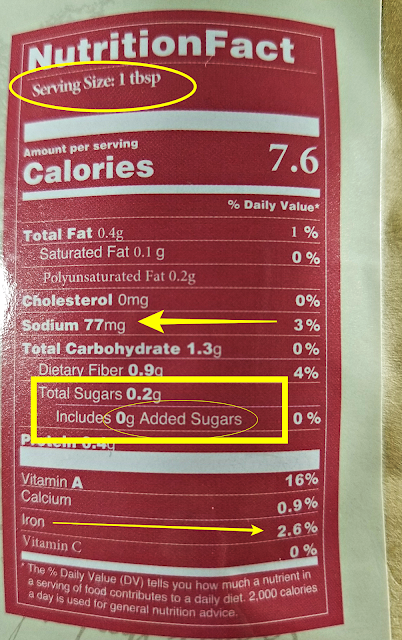One thing I have to say before I rave about my henna results: I think a lot depends on the brand. I used Rainbow Research.
I decided to try using henna because I read somewhere that it is great for taming hair that is affected by humidity. And, living here in Iowa, I can tell you a little something about humidity. Or I can show you a couple of screenshots from my phone's weather app:

Yeah. This is why I save so much money on lotion during the summer... Anyway...
Before I decided to try using henna, I did a lot of internet "research" and I read so many conflicting things.
- It's great for thin hair, straight hair, type 4C hair (mine), long hair, short hair...
- It will dry out the hair
- It will strengthen the hair
- It will damage the hair
- It will heal the hair
- Leave in overnight
- Leave it in just a little while
- Let the mixture rest before using
- Use the mixture right away
 |
| Rainbow Henna from Rainbow Research |
- Rainbow Research henna can be bought at several online places. iHerb.com is one of those places. I got my first jar from PipingRock.com and my second jar from Amazon. I won't tell people to look for "Piping Rock Henna" or "Amazon Henna"...
- Raindance Cosmetics (out of Canada) sells Rainbow Research henna.
- Maybe because of Rainbow in the name on the front (and not Rainbow Research) and being the logo, people shorten the name to "Rainbow henna" and use it generically. All photocopies are not done by Xerox but we use the term Xerox to mean a photocopy. See what I mean.
- Because I had recently dyed my hair black -very black - and regretted that. I used the Dark Brown/Sable color of henna.
- I washed my hair beforehand with a clarifying shampoo.
- The smell of this reminded me of wet grass and dirt. It's very earthy.
- It was not nearly as messy as I expected. To keep my floors, counters, and carpeting safe, I took the same precautions as when using regular dye. There were some spots on the backsplash of the kitchen sink that wiped out with some olive oil. I have some kind of plastic-material shower and the residue from rinsing wiped out easily.
- This did not stain my skin. I used the Dark Brown/Sable color. I did use gloves.
- I added olive oil to my henna mix because I wanted to protect against drying.
- I left this on for an hour with a thermal heat cap.
- I did the hot rinse first, then had to do several cold rinses. Every time I thought I was done, I saw or felt more of the gritty henna.
- After rinsing and before conditioning, my hair felt AWFUL! Like straw. Like when I used a coconut oil pre-poo. I was very worried.
- I used Aussie Moist 3-Minute Miracle (and left it on for 5 minutes!)
- That conditioner did the trick. My hair softened up even more than it usually does after deep conditioning. But the strands didn't feel weak or fragile.
- I can't tell you how well it covers grays. My regular dye job colored all of those so black that it's unnatural.
 |
| Both are about the same color. The Sable powder is slightly darker. |
Instructions: Store in a cool, dry place. Do not use in the area of the eye or if scalp has open cuts. Not for use on bleaches or white hair.
A strand test should be done if hair is over 10% grey.
Helpful Accessories: Plastic or glass bowl; Plastic or wooden spoon; Oil, vaseline, or cream; Plastic or rubber gloves; Tint brush or 1-1/2 paint brush; Cotton or tissues; Plastic bag or plastic wrap; Protective cape or old towel.
Preparation: Rainbow Henna may be applied on wet or dry hair, but it is important that the hair be clean. If you wish to shampoo first, towel hair dry. Apply cream, oil, or vaseline around the hairline, ears, and neck to avoid staining your skin.
Directions: Pour 4 oz (1 cup) Rainbow Henna into a glass or plastic bowl. Gradually add 1 cup boiling water. Use a wooden or plastic spoon to mix thoroughly to a creamy consistency. (More liquid can be added if mixture is too thick.)
For Rainbow Neutral Henna, mix 2 oz (1/2 cup) with 1 cup boiling water. Application: Wear plastic or rubber gloves to avoid staining your hands.
1. Section hair. Sections should be about 1 inch thick.
2. Begin at the scalp and paint on the Henna with a brush from roots to the ends.
3. Continue until all the hair is thickly coated with the Henna mixture.
4. Place a cotton or tissue band around the hairline. Cover the hair with a plastic bag or plastic wrap. Timing: For best results, use a dryer, heat lamp, or Thermo Heat Cap (see other fine Henna products).
Leave on as follows:
Black, red, sherry, mahogany, burgundy, dark brown, medium brown, and copper - with heat 45 minutes; without heat 60-75 minutes.
Strawberry blonde, blonde, marigold blonde, light brown and neutral - with heat 30 minutes; without heat 45-60 minutes.
When timing is completed, rinse thoroughly with hot water, then rinse with cool water. Follow with henna shampoo. Rinse thoroughly and style.
Special Recipes and Hints -
Coffee: To help tone down red tones, deepen brown-red tones, or cover grey, substitute coffee for water. Use brewed, black coffee (not instant or decaffeinated). After coffee is brewed, bring to a boil. Mix as directed.
Teas: Ceylon or black China tea will add gold highlights to light brown henna. Red zinger tea enriches red tones in burgundy, sherry, mahogany, and red henna. Chamomile tea brightens and adds highlights to neutral, blonde, or marigold blonde henna. Let tea steep for 20-30 minutes. Bring to a boil. Substitute tea for water. Mix as directed.
Apple Cider Vinegar: To help color hold on grey hair, add 2 tbsp apple cider vinegar to Henna mixture.
Lemon Juice: To lighten blonde shades, add 2 tbsp lemon juice to Henna mixture. To Deepen Red Shades: Red, sherry, mahogany, or burgundy can be deepened by mixing a darker shade. For example, 3 oz (3/4 cup) Mahogany + 1 oz (1/4 cup) Dark Brown = Dark Auburn.
Dry Hair: Add 1 egg, 2-4 tbsp olive oil, or 2-4 tbsp plain yogurt to Henna mixture. These natural ingredients not only condition, but help with the application and rinsing processes.
Questions and Answers:
Can I Try a Test Strand First? Yes. Mix about 1 tsp Henna with 1 tbsp boiling water. Apply to 1 inch section of hair (enough to wrap around a finger). Wrap in plastic wrap. Leave on for required time (see Timing). Rinse off, shampoo, and dry.
Can Henna Be Used on Grey Hair? If you have over 10% grey, we suggest doing a test strand first. The following formulas work best: Medium Brown Henna + brewed coffee + apple cider vinegar. Dark Brown Henna + brewed coffee + apple cider vinegar. Light Brown Henna + Ceylon or Black China Tea + apple cider vinegar (see Special Recipes and Hints).
Can I Henna After a Perm? Yes. After perming, wait 2 weeks or 5 shampoos before applying Henna. This will allow the hair to be free of any chemical residue.
Can I Perm After a Henna? Henna coats the hair shaft and, in some cases, prevents the chemicals in the perm lotion from penetrating. Prior to a perm, remove Henna (see following question).
What Is the Best Way To Remove Henna? To help remove Henna from the hair shaft, apply warm mineral oil to the hair. Leave on 20-25 minutes. Rinse with warm water. Shampoo out. This procedure is good prior to using a perm or chemical tint/color.
Is Henna Safe to Use Over a Chemical Tint? Yes. If the hair is in excellent condition, Rainbow Henna can be used over a chemical tint. However, this is not its purpose. Henna should never be used over bleached or white hair.
Can Hair Be Lightened After a Henna? No. The Henna color will remain on the hair even if high lift blonde tints or bleaches are used.
Will Henna Lighten Hair? No. Henna does not contain any lightening chemicals. Blonde Henna brings out yellow and light brown highlights. Marigold Blonde brings out gold and yellow highlights. Both add shine and body to grey hair.
How Often Can I Use Henna? Neutral Henna can be done every 4 weeks. All other shades can be used every 4 to 6 weeks.







































